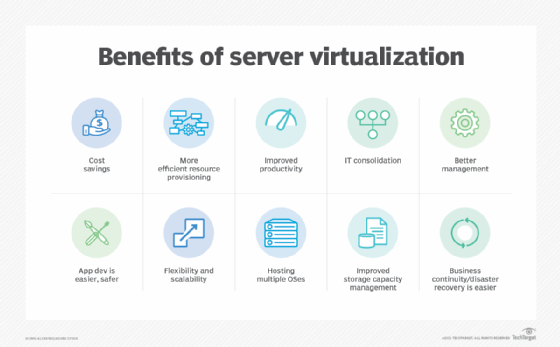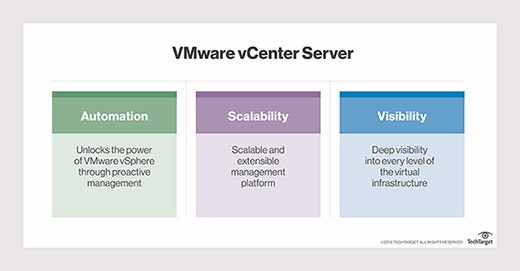What is VMware vCenter Server?
VMware vCenter Server is a centralized management platform for configuring, controlling and monitoring VMware vSphere virtual environments. The platform is implemented as a prepackaged virtual appliance that's optimized for running vCenter Server and its supporting services. The appliance simplifies deployment and maintenance, while consolidating services such as licensing, authentication and certificate management.
VMware vCenter Server provides an organization with a single, centralized platform for managing VMware ESXi hosts and their virtual machines (VMs). Administrators can provision resources, monitor performance, automate workflow, control user privileges and do much more. To support these operations, vCenter Server provides a number of key features, such as vCenter High Availability (HA), vCenter Hybrid Linked Mode and vCenter Server Profiles.
VMware vCenter Server components
The vCenter Server appliance comes with the vCenter Server software and supporting components. With a single vCenter Server instance, administrators can manage up to 2,000 hosts and 35,000 VMs.
In addition to vCenter Server, the appliance comes with two sets of services: core server services and authentication services. The set of core services includes the following components:
- VSphere Client. A Hypertext Markup Language 5 web-based interface for connecting to and managing vSphere instances. The HTML5 client replaced the original vSphere Web Client starting in vSphere 7.0.
- VSphere Auto Deploy. A management tool for provisioning hundreds of ESXi hosts. Administrators can specify which image to deploy and which hosts to provision with that image.
- VSphere ESXi Dump Collector. A configuration tool for setting up an ESXi host to save the VMkernel memory to a network server, rather than to disk. Dumps are collected when a system encounters a critical error.
- VSphere Lifecycle Manager. A centralized automation tool for managing patches, updates and upgrades on ESXi hosts and their VMs and virtual appliances.
- PostgreSQL relational database system. A database management system for storing status information about each host, VM and user in the vCenter Server environment.
These components are included as part of the vCenter installation and cannot be installed separately because they do not have their own installers. In addition to these components, a vCenter installation also includes the following set of authentication services:
- VCenter Single Sign-On. A service that brings secure authentication capabilities to the vSphere environment. The vCenter Single-Sign On (SSO) service makes it possible to authenticate users through external identity provider federation or through vCenter's built-in identity provider.
- VSphere License Service. A service that enables administrators to manage licensing on all vCenter instances within an SSO domain.
- VMware Certificate Authority (VMCA). A service that provisions each ESXi host with a signed certificate that designates VMCA as the default root certificate authority.
VMware has optimized the vCenter Server appliance for the server and its supporting services. The appliance runs the Photon operating system, a Linux-based, open source OS that has been optimized for cloud and edge computing environments.

How do I get vCenter Server?
At one time, vCenter Server was available as a standalone product, but that changed in December 2023 when VMware announced a major overhaul of its product portfolio and licensing structure. Only a few weeks earlier, Broadcom Inc. had finalized its acquisition of VMware.
Following the December announcement, VMware quickly moved from a perpetual licensing model to a subscription model. The company also discontinued some of its products and consolidated others into two main platforms: VMware Cloud Foundation (VCF) and VMware vSphere Foundation (VVF). As part of the VVF package, VMware also offered the vSphere Essentials Plus Kit edition and vSphere Standard edition, both geared toward smaller deployments.
VMware's vSphere Essentials Plus Kit, vSphere Standard and vSphere Foundation are all considered part of the vSphere product line. The Essentials Plus Kit edition is the most basic of the three, while vSphere Foundation is the most feature-rich. The vSphere Standard edition falls somewhere in between. The vSphere Foundation edition includes many of the same features as VCF, but VCF provides additional features to support large enterprise workloads.
Regardless of the product naming or its organization, all four systems have one thing in common: They include vCenter Server. However, the Essentials Plus Kit edition gets only a pared-down version of the server, which is referred to as vCenter Essentials. The other three products come with vCenter Standard, a more complete product capable of managing more hosts. Despite these differences, the important point is that vCenter Server can no longer be purchased as a standalone product and is available only through one of these four platforms.

Key features of VMware vCenter Server
VMware's vCenter Server offers a number of important features to help streamline operations and optimize virtual environments. The following are some of the more noteworthy features that come with a vCenter instance:
- VCenter Lifecycle Management Service. Provides lifecycle management for vCenter instances, while making it easier to schedule updates.
- VCenter Server Profiles. Enables administrators to define, validate and apply configuration settings on multiple vCenter Server instances.
- VCenter Server Update Planner. Gives administrators a tool for managing compatibility and interoperability related to upgrading vCenter Server instances.
- Virtual Volumes. Virtualizes external storage, while providing vCenter with VM-aware, policy-based storage management capabilities.
- VCenter HA. Automatically restarts VMs in a cluster if the physical machine fails.
- VCenter Backup and Restore. Provides native backup and restore capabilities.
- VCenter Hybrid Linked Mode. Provides administrators with a single view of their vSphere deployments across on-premises data centers and vSphere-enabled public clouds.
- VCenter extensibility. Includes a set of representational state transfer APIs for communicating and integrating vCenter with third-party software. VMware partners also offer various plugins for integrating their systems into the vCenter environment.
These are by no means the only features included with vCenter Server. In addition, many features are not available to VMware's Essentials Plus Kit edition, which is the most limited of the of the four VMware platforms.
Pros and cons of vCenter Server
VMware vCenter Server automates operations, provides visibility across virtual environments and is highly scalable. Its tools make it possible to automate a variety of processes and support proactive management capabilities. The tools also offer extensive visibility throughout the virtual environment, making it easier for administrators to configure host servers and VMs, maintain their systems and monitor performance. In addition, vCenter Server is highly scalable thanks to vCenter Hybrid Linked Mode.

According to VMware, vCenter Server streamlines VM deployments, enables administrators to continuously monitor performance and prevents unauthorized access to secure resources. The company also points to other vCenter benefits, including its ability to automate workflows, minimize the effects of system failures and simplify integration with third-party products.
A single vCenter Server instance can manage thousands of VMs, and that number only increases when Linked Mode connects multiple instances. Although that capacity is impressive, it can also be a disadvantage. Because a vCenter Server database stores all server data, the more VMs supported by a single vCenter instance, the higher the risk of exceeding the database's limits, which might require the purchase of an additional vCenter instance.
Choosing the right server virtualization management software is critical to meeting your organization's current and future needs. See how to find the best server virtualization management software for your environment.







